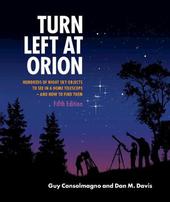
|
Turn Left at Orion: Hundreds of Night Sky Objects to See in a Home Telescope - and How to Find Them
Spiral bound
Main Details
| Title |
Turn Left at Orion: Hundreds of Night Sky Objects to See in a Home Telescope - and How to Find Them
|
| Authors and Contributors |
By (author) Guy Consolmagno
|
|
By (author) Dan M. Davis
|
| Physical Properties |
| Format:Spiral bound | | Pages:256 | | Dimensions(mm): Height 310,Width 262 |
|
| Category/Genre | Popular science
Astronomical charts and atlases
Popular astronomy and space |
|---|
| ISBN/Barcode |
9781108457569
|
| Classifications | Dewey:522 |
|---|
| Audience | | Tertiary Education (US: College) | | General | |
|---|
| Edition |
5th Revised edition
|
| Illustrations |
Worked examples or Exercises
|
|
Publishing Details |
| Publisher |
Cambridge University Press
|
| Imprint |
Cambridge University Press
|
| Publication Date |
24 January 2019 |
| Publication Country |
United Kingdom
|
Description
With over 150,000 copies sold since its first publication, this is one of the most popular astronomy books of all time. This unique guidebook to the night sky shows you how to observe a host of celestial wonders. Its distinct format of object-by-object spreads illustrates how deep-sky objects and planets actually look through a small telescope, while its large pages and spiral binding allow for use outside. Along with updated star names and astronomical information, this new edition provides links to a dedicated webpage with up-to-date tables and images, and an improved planets chapter. The many Dobsonian-friendly images and small telescope views have been revised to account for changes in modern telescope technology, such as larger field of view eyepieces. With dedicated chapters on Northern and Southern Hemisphere objects, it's never been easier to explore the night sky, wherever you are. Additional resources are available on the accompanying website: www.cambridge.org/turnleft.
Author Biography
Guy Consolmagno is the Director of the Vatican Observatory, Vatican City. He is the author of over 200 scientific publications, primarily on meteorite and asteroid properties. The International Astronomical Union named asteroid 4597 Consolmagno in recognition of his work, and in 2014 he won the Carl Sagan Medal for public outreach from the American Astronomical Society. He uses a 3.5' catadioptric and an 8' Dobsonian telescope. Dan M. Davis is a Professor in the Department of Earth and Space Sciences at Stony Brook University, State University of New York. His research is in terrestrial tectonics and geophysics. A lifelong amateur stargazer, his observations for this book were made with a 2.4' refractor, an 8' catadioptric, and a 10' Dobsonian telescope.
ReviewsPraise for previous editions: 'This is quite possibly the most inviting guidebook ever written to help people with binoculars and small telescopes find, view, understand, and most of all, enjoy everything in the night sky from the Moon and planets to distant star clusters, nebulae, and galaxies. And if you think it's only for beginners, think again - every telescope owner should have a copy.' Dennis Di Cicco, Senior Editor, Sky & Telescope Praise for previous editions: 'Turn Left at Orion is an essential guide for both beginners and more experienced amateur astronomers who will find much inside to reinvigorate their passion for the stars. The diagrams are simple, clear and functional, and the text eloquently captures the excitement of observing. Stargazing has never been made so easy, and if you buy just one book on observational astronomy, make sure it's this one.' Keith Cooper, Editor, Astronomy Now Praise for previous editions: 'Since it first appeared in 1989, Turn Left at Orion has been an indispensable guidebook for the amateur astronomer possessing nothing more than a small backyard telescope. This is not only an essential handbook for the novice, it's a useful reference for the seasoned backyard astronomer. Simply put, whatever your level of experience, you must have this book!' Glenn Chaple, Contributing Editor, Astronomy 'The book fills a gap between guides to the constellations for newcomers and detailed star atlases. I will have no hesitation in recommending it at outreach events to those who are interested enough in astronomy to buy a small telescope.' Mike Rushton, The Observatory
|